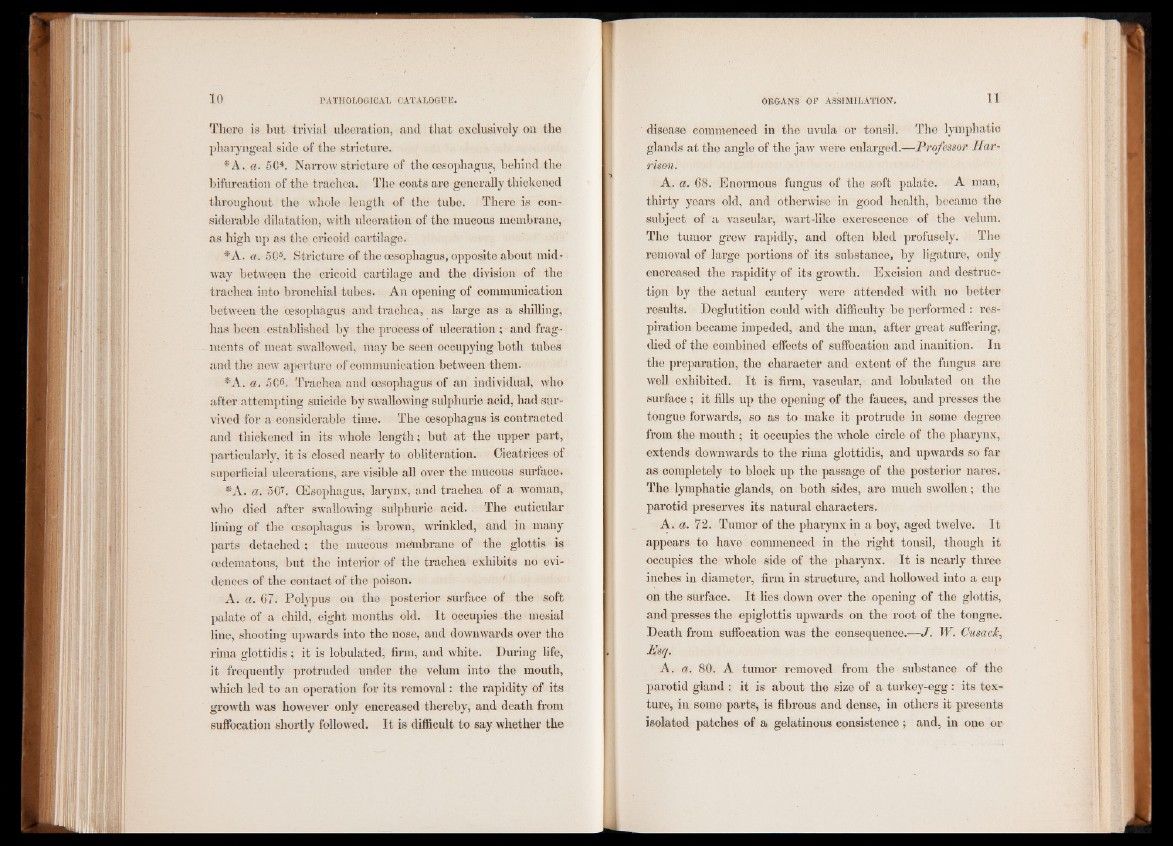
There is but trivial ulceration, and that exclusively on the
pharyngeal side of the stricture.
*A. a. 504. Narrow stricture of the oesophagus, behind the
bifurcation of the trachea. The coats are generally thickened
throughout the whole length of the tubo. There is considerable
dilatation, with ulceration of the mucous membrane,
as high up as the cricoid cartilage.
*A. a. 50s. Stricture of the oesophagus, opposite about midway
between the cricoid cartilage and the division of the
trachea into bronchial tubes. An opening of communication
between the oesophagus and trachea, as large as a shilling,
has been established by the process of ulceration p and fragments
of meat swallowed, may be seen occupying both tubes
and the new aperture of communication between them.
*A. a. 5C6. Trachea and oesophagus of an individual, who
after attempting suicide by swallowing sulphuric acid, had survived
for a considerable time. The oesophagus is contracted
and thickened in its whole length; but at the upper part,
particularly, it is closed nearly to obliteration. Cicatrices of
superficial ulcerations, are visible all over the mucous surface.
*A. a. 50T. CEsophagus, larynx, and trachea of a woman,
who died after swallowing sulphuric acid. The cutieular
lining of the oesophagus is brown, wrinkled, and in many
parts detached ; the mucous membrane of the glottis is
cedematous, but the interior of the trachea exhibits no evidences
of the contact of the poison.
A. a. 67. Polypus on the posterior surface of the soft
palate of a child, eight months old. It occupies the mesial
line, shooting upwards into the nose, and downwards over the
rima glottidis ; it is lobulated, firm, and white. During life,
it frequently protruded under the velum into the mouth,
which led to an operation for its removal: the rapidity of its
growth was however only encreased thereby, and death from
suffocation shortly followed. It is difficult to say whether the
disease commenced in the uvula or tonsil. The lymphatic
glands at the angle of the jaw were enlarged.—Professor Harrison.
A. a. 68. Enormous fungus of the soft palate. A man,
thirty years old, and otherwise in good health, became the
subject of a vascular, wart-like excrescence of the velum.
The tumor grew rapidly, and often bled profusely. The
removal of large portions of its substance, by ligature, only
encreased the rapidity of its growth. Excision and destruction
by the actual cautery were attended with no better
results. Deglutition could with difficulty be performed : respiration
became impeded, and the man, after great suffering,
died of the combined effects of suffocation and inanition. In
the preparation, the character and extent of the fungus are
well exhibited. It is firm, vascular, and lobulated on the
surface ; it fills up the opening of the fauces, and presses the
tongue forwards, so as to make it protrude in some degree
from the mouth ; it occupies the whole circle of the pharynx,
extends downwards to the rima glottidis, and upwards so far
as completely to block up the passage of the posterior nares.
The lymphatic glands, on both sides, are much swollen; the
parotid preserves its natural characters.
A. a. 72. Tumor of the pharynx in a boy, aged twelve. It
appears to have commenced in the right tonsil, though it
occupies the whole side of the pharynx. It is nearly three
inches in diameter, firm in structure, and hollowed into a cup
on the surface. It lies down over the opening of the glottis,
and presses the epiglottis upwards on the root of the tongue.
Death from suffocation was the consequence.—-J. W. Cusack,
Esq.
A. a. 80. A tumor removed from the substance of the
parotid gland : it is about the size of a turkey-egg: its texture,
in some parts, is fibrous and dense, in others it presents
isolated patches of a gelatinous consistence ; and, in one or